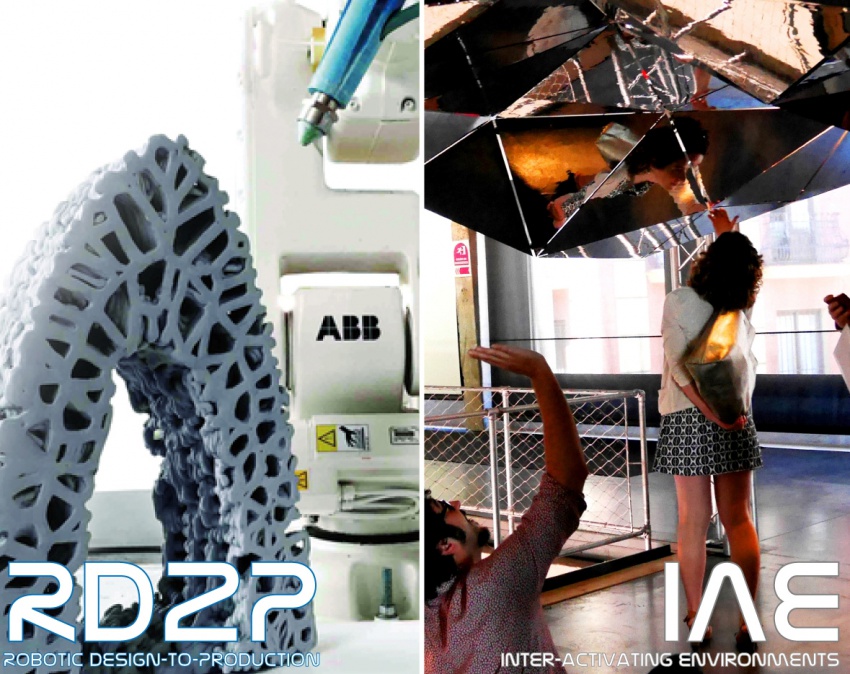Difference between revisions of "Main Page"
Marco Galli (Talk | contribs) |
Gary Chang (Talk | contribs) |
||
| Line 16: | Line 16: | ||
<br><br> | <br><br> | ||
IAE is directly connected with an European Union Project called METABODY, which the Hyperbody team is currently engaged with. Within this EU project, Hyperbody’s agenda is to develop a pro-active architectural pavillion, which will, in real-time communicate with its immediate context (body movement, directionality of movement, micro-gestures, environmental parameters etc) via multi-modal interactions (sound, light, movement of the structure etc). Currently a fully robotic structural loop is being developed by the Hyperbody staff in collaboration with the Delft Robotics Institute and other consortium members of the EU Project. The structural loop and its movements will thus serve as a constraint, within which the students shall conceive interactive skins/bodies. | IAE is directly connected with an European Union Project called METABODY, which the Hyperbody team is currently engaged with. Within this EU project, Hyperbody’s agenda is to develop a pro-active architectural pavillion, which will, in real-time communicate with its immediate context (body movement, directionality of movement, micro-gestures, environmental parameters etc) via multi-modal interactions (sound, light, movement of the structure etc). Currently a fully robotic structural loop is being developed by the Hyperbody staff in collaboration with the Delft Robotics Institute and other consortium members of the EU Project. The structural loop and its movements will thus serve as a constraint, within which the students shall conceive interactive skins/bodies. | ||
| + | IAE design studio is With the support of the Culture Programme of the EU. | ||
| + | [[File:EU_flag.jpg]] | ||
</div> | </div> | ||
Revision as of 10:32, 23 March 2016
HYPERBODY Robotic Environments | RE | Spring Semester 2015
TUTORS: Kas Oosterhuis, Henriette Bier, Nimish Biloria, Sina Mostafavi, Gary Chang, Serban Bodea, Ana Anton Pablo Baquero, Veronika Laszlo
Technological and conceptual advances in fields such as artificial intelligence, robotics, and material science have enabled robotic building to be in the last decade prototypically implemented. In this context, robotic building implies both physically built robotic environments and robotically supported building processes, whereas reconfigurable, robotic environments incorporating sensor-actuator mechanisms that enable buildings to interact with their users and surroundings in real-time require design to production, assembly, and operation chains that may be (in part or as whole) implemented by robotic means (Bier, 2013). 2015, the MSc 2 project will address physically built robotic environments and robotically supported building processes with two groups of students, one focusing on numerically controlled (NC) and robotic design-to-production (D2P) processes and the other one on embedded sensor-actuator technologies to develop Inter-Activating Environments.

RD2P focuses on linking design to materialisation by integrating all functionalities (from structural strength, to thermal insulation and climate control) in the design of building components. This is implemented by employing novel multi-performative D2P strategies. New materials are developed for the robotic production of multi-material building components and novel robotic production and assembly tools are deployed for testing the blueprint of future robotic building.
RD2P establishes the framework allowing successful implementation of robotic production at building scale. The main consideration is that in architecture and building construction the factory of the future employs building materials and components that can be robotically processed and assembled. RD2P processes incorporate material properties in design, control all aspects of the processes numerically, and utilise parametric design principles that can be linked to the robotic production. The aim is to develop RD2P for student housing located on the TUD campus (51.996950, 4.376548) by taking into consideration requirements with respect to function/use, form, structure, climate, and (mechanical-electrical-plumbing) MEP.
IAE will operate on the premise that bodily motion and non-verbal communication can be understood as interfaces of emotional expression and cognition. The idea of creating a proactive behavior loop between the body, the physical and ambient space it operates within as well as the tools and techniques offered by contemporary new media technologies shall be a central operational logic driving the studio.
IAE is directly connected with an European Union Project called METABODY, which the Hyperbody team is currently engaged with. Within this EU project, Hyperbody’s agenda is to develop a pro-active architectural pavillion, which will, in real-time communicate with its immediate context (body movement, directionality of movement, micro-gestures, environmental parameters etc) via multi-modal interactions (sound, light, movement of the structure etc). Currently a fully robotic structural loop is being developed by the Hyperbody staff in collaboration with the Delft Robotics Institute and other consortium members of the EU Project. The structural loop and its movements will thus serve as a constraint, within which the students shall conceive interactive skins/bodies.
IAE design studio is With the support of the Culture Programme of the EU.
